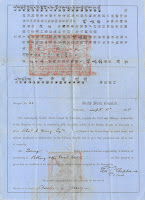 While at Dartmouth, Young's reputation was such that in May of 1874 he received a telegram from another major luminary in the field astronomy, James C. Watson. Watson was an astronomical prodigy who was, among other accomplishments, a recipient of the prestigious Lalande Prize in 1867 and the director of the Ann Arbor Observatory. Upon his death, a bequest from his estate established the James Craig Watson Medal, an honor that is still awarded today by the United States National Academy of Sciences for contributions to the field of astronomy. In the 1860s and 1870s, Watson was involved in some of the most important astronomical observations commissioned by the U. S. Government, and his message to Young was an invitation to join him on a trip to Peking, China, to witness the rare occurrence of the transit of the planet Venus across the face of the sun. After securing his passport, Young embarked upon a long journey across the Pacific to China as a member of one of eight separate observation groups sent out by the U. S. to observe the transit.
While at Dartmouth, Young's reputation was such that in May of 1874 he received a telegram from another major luminary in the field astronomy, James C. Watson. Watson was an astronomical prodigy who was, among other accomplishments, a recipient of the prestigious Lalande Prize in 1867 and the director of the Ann Arbor Observatory. Upon his death, a bequest from his estate established the James Craig Watson Medal, an honor that is still awarded today by the United States National Academy of Sciences for contributions to the field of astronomy. In the 1860s and 1870s, Watson was involved in some of the most important astronomical observations commissioned by the U. S. Government, and his message to Young was an invitation to join him on a trip to Peking, China, to witness the rare occurrence of the transit of the planet Venus across the face of the sun. After securing his passport, Young embarked upon a long journey across the Pacific to China as a member of one of eight separate observation groups sent out by the U. S. to observe the transit.In addition to bringing back stereoscope cards of Peking and his observations on the transit, Young also returned with numerous fascinating Chinese books and other souvenirs from his visit abroad. To explore the rest of the Charles A. Young papers, which contain photographs, scientific data, and correspondence, come to Rauner and ask to see ML-49. Young's passport is MS 874511, and his alumni file is filled with articles and photographs from different stages of his life and career.


No comments:
Post a Comment